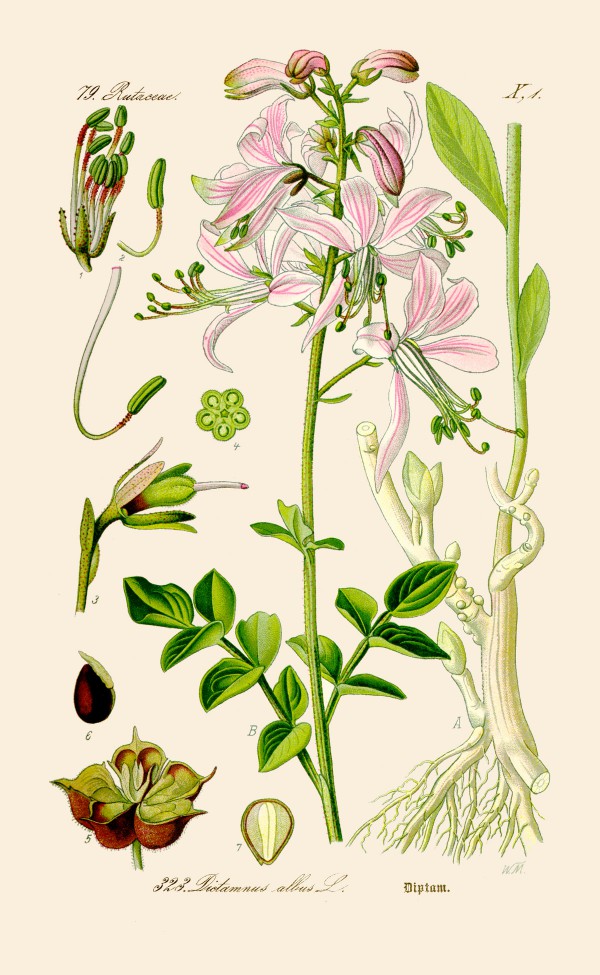Dies ist eine alte Version des Dokuments!
Dictamnus albus L. - Rutaceae - burning bush, false dittany, white dittany, gas plant, Diptam
Perennial herb, up to 90cm tall, native to Southwestern Europe, southern and central Asia to China and Korea; leaves glossy, odd-pinnate, light green, emitting a lemony fragrance when rubbed or crushed; racemes of fragrant, 5-petaled, white or pink flowers.
„Foliage also contains an oil that causes allergic reactions (skin rash) in some individuals. In hot weather, old flowers or seed pods emit a flammable oil which, on a windless summer evening, can be ignited with a match resulting in a brief vapor burn which is harmless to the plant, hence the common name.“
http://www.missouribotanicalgarden.org/PlantFinder/PlantFinderDetails.aspx?kempercode=c490
„Semi-dried, flowering leafy branches were subjected to water distillation: three days after collection
(A), and after fully drying for one year (B). The oils were separately analysed by gas chromatography (GC) and gas chromatography-mass spectrometry (GC/MS) techniques. Twenty-one components were identified making up 97.87 % (A) and 94.70% (B) of both oils (Table 1). The main components in the oils were identified as dictagymnin [1-allyl-4-(3-methyl-3-butenyloxy)-benzene], feniculin [1-(3-methyl-2-butenyloxy)-4-propylbenzene], methylchavicol (= estragole), and trans-anethol. The amounts of dictagymnin and feniculin in oil from dried plant material analysed one year after collection were greater than in oil from semi-dried plant material, while the percentage amounts of methylchavicol and trans-anethol were lower….
The oil from D. albus of German origin was reported to contain limonene, myrcene, and terpinolene as
major components. Limonene and methylchavicol were reported to be the major constituents of D. hispanicus oil . In D. albus oil of Russian origin, anethol and methyl-chavicol were identified as major constituents. The composition of oils in this study closely resemble that of D. gymnostylis. Since the Flora of Turkey and Flora Europea do not recognize any species of Dictamnus other than D. albus, our Turkish material can be recorded as a new chemotype. This is the first report for the co-occurrence of dictagymnin and feniculin in an essential oil.“
[The Essential Oil Composition of Dictamnus albus from Turkey, K. Hüsnü Can Başer, Müberra Koşar, Hulusi Malyer, Temel Özek, Planta Med. 60 (1994), 481-482]
„The detailed study of volatiles of Dictamnus gymnostylis Steven. (Dictamnus albus L., original polymorphic species) considered by many to be the Burning Bush of the Bible, was conducted. In addition to methyl chavicol (~15%), (E)-anethole (~7%) and psoralen (~7%), the presence of over 60% of 1-allyl-4- (3-methyl-2-butenyloxy) benzene (dictagymnin) was confirmed. It was shown that this chemical rather easily decomposes into chavicol and very flammable hydrocarbon 2-methyl-1,3-butadiene = isoprene (b.p. 34°C). The secretion of isoprene, which can be especially intense on hot windless days, leads to formation of the isoprene cloud that may inflame without any harm to the source plant.“
[Study of Dictamnus gymnostylis Volatiles and Plausible Explanation of the “Burning Bush” Phenomenon, Alexander Fleisher, Zhenia Fleisher, Journal of Essential Oil Research, Vol. 16 (1), 2004, 1-3]
The lemony and slightly herbal scent of this plant eminates not only from the flowers, but much more from the glandular cells spread over leaves and stems. Elevated temperature or slightest external force may liberate the volatiles as scent, which is especially based on (headspace of touched inflorescense) citronellal (0.1%), neral (1.8%), and geranial (7.2%), contributing citrus notes, embedded in a monoterpene matrix with myrcene (15.1%), limonene (27.0%), γ-terpinene (16.6%), and terpinolene (13.2%) and supported by minor amounts of (Z,Z)-4,7-decadienal (0.02%, algae-herbal), and (Z)-5-dodecenal (0.05%, orange-related).
[Scent of a vanishing flora, Roman Kaiser, 2011, 180-182 and 349]
„We report two patients with bullous phototoxic contact dermatitis caused by Dictamnus albus L. (gas plant) which belongs to the Rutaceae family. In both cases long lasting postinflammatory hyperpigmentations were observed as a result of the phototoxic contact dermatitis. The phototoxic components of Dictamnus albus L. are the furocoumarins 5-methoxypsoralen (bergapten) and 8-methoxypsoralen, and the alkaloid dictamnin whose phototoxic properties were recently discovered. Even though reactions to the gas plant have been infrequently reported, it is becoming more popular with gardenus and should be considered in the differential diagnosis of phototoxic contact dermatitis.“
[Dermatitis bullosa striata pratensis durch Dictamnus albus L. (Brennender Busch). Christoph M. Schempp, Monika Sonntag, Erwin Schöpf, Jan C. Simon, Der Hautarzt, Vol.47 (9), 1996, 708-710]

Thomé,O.W., Flora von Deutschland Österreich und der Schweiz, Tafeln, vol.3, t.323 (1885)
http://plantgenera.org/species.php?id_species=339674
